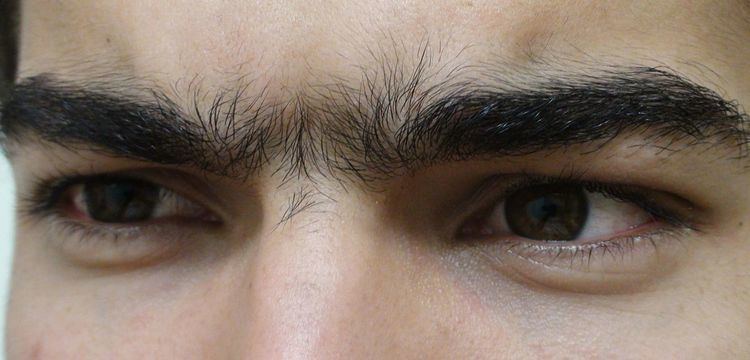 | ||
A unibrow (or monobrow; called synophrys in medicine) is a single eyebrow created when the two eyebrows meet in the middle above the bridge of the nose. The hair above the bridge of the nose is usually of the same color and thickness as the eyebrows, giving the appearance that they converge to form one uninterrupted line of hair.
Contents
History
The first known use of the word 'unibrow' was in 1988.
Negative association
Among most Westerners, the region between the eyebrows is often plucked, waxed, shaved, or treated with electrology or laser hair removal.
Positive association
The unibrow has been prized by many cultures throughout history.
Ancient Greece and Rome
In both Ancient Greek and Roman cultures, unibrows were prized as beautiful, desirable features worn by the most intelligent and lusted-after women. In Ancient Greece, women used powdered minerals or soot to paint their brows black. The Greeks valued purity, so women often left their unibrows untouched or darkened slightly with black powder. Eyebrows were also part of the Romans' elaborate beauty rituals, and like the Greeks, they favored a unibrow. Both cultures' poets and writers described women donning false unibrows to enhance their looks. These were made of dyed goat's hair and attached with tree resin.
Tajikistan
In Tajikistan, a unibrow is viewed as an attractive quality in both men and women. For women, it is associated with virginity and purity and, in men, virility. If there is no unibrow present, or if it is weak, it is commonplace for women to use a kohl liner or a modern kajal pen to simulate a unibrow.
Iran
During the Qajar dynasty in Iran (1785-1925), connected brows were considered beautiful. Persian poetry lauded the abrou-ye peyvasteh or "continuous eyebrow", in men and women alike. It was compared to cupid's bow, tensed and ready to fire its dart. The classic shape – a beautiful inverted ogee – can be seen in courtly miniatures and royal portraits [citation needed].
Art
Crime
Fiction
Art, entertainment, and media
Politics
Sports
Genetics
The unibrow is a recessive genetic trait.
Medical conditions
A unibrow is part of normal human variation, but can also stem from developmental disorders. A unibrow is a recognized feature of Cornelia De Lange syndrome, a genetic disorder whose main features include moderate to severe learning difficulties, limb abnormalities such as oligodactyly (fewer than normal fingers or toes) and phocomelia (malformed limbs), and facial abnormalities including a long philtrum (the slight depression/line between the nose and mouth).
Other medical conditions associated with a unibrow include:
